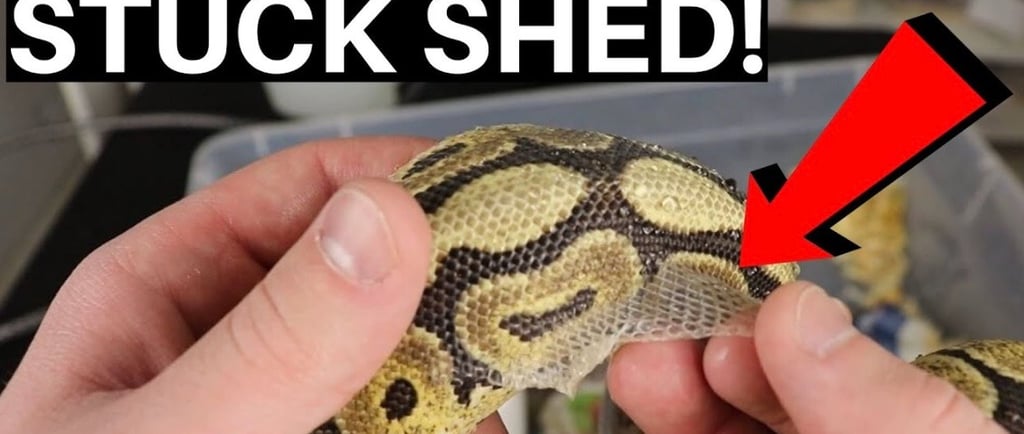Stuck Shed? Now What!
hedding is a natural part of a reptile’s life, especially for snakes like Ball Pythons. But sometimes, things don’t go smoothly, and you’re left staring at bits of stuck skin and wondering what to do next. Don't worry—it happens even to the best reptile keepers. The good news? It’s usually fixable. Here’s what you need to know about stuck shed: what causes it and how to help your reptile recover comfortably.
Emerald City Reptiles
8/5/20252 min read


Stuck Shed? Now What!
Shedding is a natural part of a reptile’s life, especially for snakes like Ball Pythons. But sometimes, things don’t go smoothly, and you’re left staring at bits of stuck skin and wondering what to do next. Don't worry—it happens even to the best reptile keepers. The good news? It’s usually fixable. Here’s what you need to know about stuck shed: what causes it and how to help your reptile recover comfortably.
What Is a Stuck Shed?
Stuck shed, also called retained shed, is when a reptile doesn’t shed its skin properly. Instead of coming off in one clean piece (as it should in a healthy Ball Python), pieces of old skin remain attached—commonly around the tail tip, eyes (eye caps), or patches on the body. Left untreated, it can cause discomfort, restricted blood flow, or infection.
Common Causes of Stuck Shed
Low Humidity
This is the most common cause, especially for tropical reptiles like Ball Pythons. If the humidity in their enclosure drops too low, the skin dries out and doesn’t separate properly.
Improper Husbandry
Inadequate heat, poor substrate choice, and lack of rough surfaces can all contribute to poor shedding.
Dehydration
A dehydrated reptile will struggle to shed. If they’re not drinking enough or the enclosure isn’t providing proper hydration opportunities, stuck shed can follow.
Stress or Illness
Stress from handling, relocation, or illness can interfere with a snake’s ability to shed cleanly.
Young or Malnourished Animals
Hatchlings and underfed reptiles may struggle more frequently with shedding issues due to fast growth or weak overall health.
How to Help Your Reptile with a Stuck Shed
1. Boost the Humidity
Increase humidity in the enclosure to at least 60–70% for Ball Pythons. During shed, even up to 80% is fine.
Add a humid hide with damp moss or paper towels.
Mist the enclosure lightly, but be careful not to soak the substrate.
2. Provide a Soak
Soak your reptile in lukewarm water (around 80–85°F) for 15–20 minutes. Do this in a shallow tub with a towel at the bottom so they don’t slip.
Never leave your reptile unattended during the soak.
3. Gently Assist (If Needed)
After a soak, gently rub the stuck shed with a damp cloth or your fingers. Don’t pull if it doesn’t come off easily—you could damage new skin.
You can also use shed aid products designed for reptiles, though they’re not always necessary.
4. Check the Eye Caps and Tail Tip
These areas are often missed during a bad shed and can lead to bigger issues. If shed is retained on the eyes (eye caps), don't force it—seek help from a reptile vet if they don’t come off after several gentle
soaks.
5. Upgrade the Enclosure Setup
Make sure your heating and humidity are dialed in and that your reptile has access to water and hiding spots.
Consider switching to substrates like cypress mulch, coco husk, or ReptiChip for better humidity retention.
Preventing Stuck Shed in the Future
Monitor humidity daily with a reliable hygrometer.
Ensure proper hydration—always keep fresh water available.
Feed a balanced diet and maintain a healthy weight.
Limit handling during shed cycles to reduce stress.
Provide enrichment like climbing branches and rough surfaces to aid natural shedding.
Final Thoughts
Stuck shed can be frustrating, but it’s usually a sign that something in your setup needs adjusting. With a little care and attention, you can get your reptile back on track and ensure clean, healthy sheds in the future. As always, if you’re unsure or the problem persists, it’s best to consult a reptile-savvy vet.
Blog / Ball Pythons
Explore our insights on ball python breeding.
CONTACT
Sign Up for Updates no spam
info@ecreptiles.com
© 2025. Emerald City Reptiles All rights reserved.


